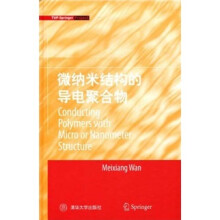微纳米结构的导电聚合物(国内版)

目 录内容简介
Chapter I Introduction of Conducting Polymers
1.1 Discovery of Conducting Polymers
1.2 Structural Characteristics and Doping Concept
1.3 Charge Carriers and Conducting Mechanism
References
Chapter 2 Polyaniline as A Promising Conducting Polymer
2.1 Molecular Structure and Proton Doping
2.2 Synthesis Method
2.2.1 Chemical Method
2.2.2 Electro-Chemical Method
2.2.3 Mechano-Chemical Route
2.3 Physical Properties .
2.3.1 Nonlinear Optical (NLO)
2.3.2 Electrical and Charge Transport Properties
2.3.3 Magnetic Properties
2.3.4 Other Properties
2.4 Solubility and Processability
2.4.1 Solubility
2.4.2 Processability
References
Chapter 3 Physical Properties and Associated Applications of Conducting Polymers
3.1 Electronic Devices
3.1.1 Light Emitting Diodes (LEDs)
3.1.2 Solar Cells
3.2 EMI Shielding and Microwave Absorbing Materials
3.2.1 EMI Shielding Materials
3.2.2 Microwave Absorption Materials (Stealth Materials)
3.3 Rechargeable Batteries and Supercapacitors
3.3.1 Rechargeable Batteries
3.3.2 Supercapacitors
3.4 Sensors
3.5 Electrochromic Devices and Artificial Muscles
3.5.1 Electrochromic Devices
3.5.2 Conducting Polymer-Based Artificial Muscles
3.6 Others
3.6.1 Corrosion Materials
3.6.2 Electrostatic Dissipation Materials
3.6.3 Separated Membrane
3.6.4 Conducting Textiles
References
Chapter 4 Conducting Polymer Nanostructures
4.1 Synthetic Method and Formation Mechanism
4.1.1 Hard Template Method
4.1.2 Soft Template Method
4.1.3 Other Methods
4.1.4 PEDOT Nanostructures
4.2 Composite Nanostructures
4.2.1 Metal-Conducting Polymer Composite Nanostructures
4.2.2 Conducting Polymer/Carbon Nanotube Composites
4.2.3 Core-Shell Composites
4.2.4 Chiral and Biological Composite Nanostructures
4.2.5 Inorganic Oxide Nano-Crystals and CP Composites
4.3 Physical Properties and Potential Application
4.3.1 Electrical and Transport Properties
4.3.2 Potential Applications
4.3.3 Nano-arrays or Nano-patents
References
Chapter 5 Template-Free Method to Conducting Polymer MicrofNanostructures
5.1 Template-Free Method
5.1.1 Discovery of Template-Free Method
5.1.2 Universality of Template-Free Method
5.1.3 Controllability of Morphology and Diameter by Template-Free Method
5.1.4 Self-Assembly Mechanism of Micro/Nanostructures by A Template-Free Method
5.2 Multi-Functionality of Micro/Nanostmctures Based on Template-Free Method
5.2.1 Processing Composite Nanostructures
5.2.2 PPy-CNT Composite Nanostructures
5.2.3 Electro-Magnetic Functional Micro/Nanostructures
5.2.4 Electro-Optic Micro/Nanostructures
5.2.5 Super-Hydrophobic 3D-Microstructures Assembled from 1D-Nanofibers
5.3 Mono-Dispersed and Oriented Micro/Nanostructures
5.3. I Template-Free Method Combined with A1203 Template for Oriented Nanowires
5.3.2 Template-Free Method Associated with A Deposition to Mono-Dispersed and Oriented Microspheres
5.4 Electrical and Transport Properties of Conducting Polymer Nanostructures
5.4.1 Room Temperature Conductivity
5.4.2 Temperature Dependence of Conductivity
5.4.3 Electrical Properties of A Single Micro/Nanostructure
5.4.4 Magneto-Resistance
5.5 Special Methods for Micro/Nanostructures of Conducting Polymers
5.5.1 Aniline/Citric Acid Salts as The "Hard-Templates" for Brain-like Nanostructures
5.5.2 Cu20 Crystal as A Hard Template
5.5.3 Water-Assisted Fabrication of PANI-DBSA Honeycomb Structure
5.5.4 Reversed Micro-Emulsion Polymerization
5.6 Potential Applications of Conducting Polymer with Micro/Nanostructures
5.6.1 Microwave Absorbing Materials
5.6.2 EMI Shielding Materials
5.6.3 Conducting Polymer Nanostructure-Based Sensors Guided by Reversible Wettability
References
Appendix Term Definitions
1.1 Discovery of Conducting Polymers
1.2 Structural Characteristics and Doping Concept
1.3 Charge Carriers and Conducting Mechanism
References
Chapter 2 Polyaniline as A Promising Conducting Polymer
2.1 Molecular Structure and Proton Doping
2.2 Synthesis Method
2.2.1 Chemical Method
2.2.2 Electro-Chemical Method
2.2.3 Mechano-Chemical Route
2.3 Physical Properties .
2.3.1 Nonlinear Optical (NLO)
2.3.2 Electrical and Charge Transport Properties
2.3.3 Magnetic Properties
2.3.4 Other Properties
2.4 Solubility and Processability
2.4.1 Solubility
2.4.2 Processability
References
Chapter 3 Physical Properties and Associated Applications of Conducting Polymers
3.1 Electronic Devices
3.1.1 Light Emitting Diodes (LEDs)
3.1.2 Solar Cells
3.2 EMI Shielding and Microwave Absorbing Materials
3.2.1 EMI Shielding Materials
3.2.2 Microwave Absorption Materials (Stealth Materials)
3.3 Rechargeable Batteries and Supercapacitors
3.3.1 Rechargeable Batteries
3.3.2 Supercapacitors
3.4 Sensors
3.5 Electrochromic Devices and Artificial Muscles
3.5.1 Electrochromic Devices
3.5.2 Conducting Polymer-Based Artificial Muscles
3.6 Others
3.6.1 Corrosion Materials
3.6.2 Electrostatic Dissipation Materials
3.6.3 Separated Membrane
3.6.4 Conducting Textiles
References
Chapter 4 Conducting Polymer Nanostructures
4.1 Synthetic Method and Formation Mechanism
4.1.1 Hard Template Method
4.1.2 Soft Template Method
4.1.3 Other Methods
4.1.4 PEDOT Nanostructures
4.2 Composite Nanostructures
4.2.1 Metal-Conducting Polymer Composite Nanostructures
4.2.2 Conducting Polymer/Carbon Nanotube Composites
4.2.3 Core-Shell Composites
4.2.4 Chiral and Biological Composite Nanostructures
4.2.5 Inorganic Oxide Nano-Crystals and CP Composites
4.3 Physical Properties and Potential Application
4.3.1 Electrical and Transport Properties
4.3.2 Potential Applications
4.3.3 Nano-arrays or Nano-patents
References
Chapter 5 Template-Free Method to Conducting Polymer MicrofNanostructures
5.1 Template-Free Method
5.1.1 Discovery of Template-Free Method
5.1.2 Universality of Template-Free Method
5.1.3 Controllability of Morphology and Diameter by Template-Free Method
5.1.4 Self-Assembly Mechanism of Micro/Nanostructures by A Template-Free Method
5.2 Multi-Functionality of Micro/Nanostmctures Based on Template-Free Method
5.2.1 Processing Composite Nanostructures
5.2.2 PPy-CNT Composite Nanostructures
5.2.3 Electro-Magnetic Functional Micro/Nanostructures
5.2.4 Electro-Optic Micro/Nanostructures
5.2.5 Super-Hydrophobic 3D-Microstructures Assembled from 1D-Nanofibers
5.3 Mono-Dispersed and Oriented Micro/Nanostructures
5.3. I Template-Free Method Combined with A1203 Template for Oriented Nanowires
5.3.2 Template-Free Method Associated with A Deposition to Mono-Dispersed and Oriented Microspheres
5.4 Electrical and Transport Properties of Conducting Polymer Nanostructures
5.4.1 Room Temperature Conductivity
5.4.2 Temperature Dependence of Conductivity
5.4.3 Electrical Properties of A Single Micro/Nanostructure
5.4.4 Magneto-Resistance
5.5 Special Methods for Micro/Nanostructures of Conducting Polymers
5.5.1 Aniline/Citric Acid Salts as The "Hard-Templates" for Brain-like Nanostructures
5.5.2 Cu20 Crystal as A Hard Template
5.5.3 Water-Assisted Fabrication of PANI-DBSA Honeycomb Structure
5.5.4 Reversed Micro-Emulsion Polymerization
5.6 Potential Applications of Conducting Polymer with Micro/Nanostructures
5.6.1 Microwave Absorbing Materials
5.6.2 EMI Shielding Materials
5.6.3 Conducting Polymer Nanostructure-Based Sensors Guided by Reversible Wettability
References
Appendix Term Definitions
目 录内容简介
《微纳米结构的导电聚合物》适合高校和科研院所的化学、化工、物理及材料专业的研究人员、教师和研究生阅读参考。导电聚合物打破了聚合物为绝缘体的传统观念,因而被称为“第四代聚合物”。它既具有金属和半导体的导电特性,又保留了聚合物的轻质、柔性和可加工的特色。这种材料在光电子器件、传感技术、分子电子学和纳米器件以及驱动器件等方面具有潜在的应用前景。《微纳米结构的导电聚合物》比较完整、系统地介绍了导电聚合物的缘起、掺杂与导电机制、结构与性能、技术应用前景以及研究进展,特别介绍了作者采用无模板自组装方法在微纳米结构的导电聚合物的研究及其应用方面的学术贡献。《微纳米结构的导电聚合物》的内容分为5章:第1章,导论;第2章,优异的导电聚苯胺;第3章,导电聚合物的物理特性及其应用;第4章,导电聚合物的微纳米结构;第5章,无模板法自组装导电聚合物的微纳米结构。为了便于读者阅读,作者还特别给出了名词解释。
比价列表
公众号、微信群
 缺书网
缺书网微信公众号
 扫码进群
扫码进群实时获取购书优惠




